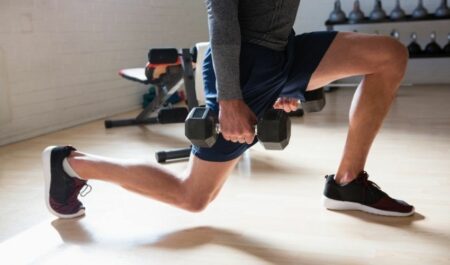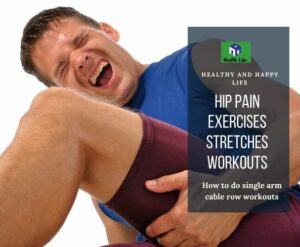As you exercise your hip muscles you cannot stay away from cable hip extensions. The exercise is good at strengthening your hip muscles. In the following paragraphs, there are several hip extension exercises that you can do that target various hip muscles. Some of them require the use of a cable machine. For instance, there are exercises such as cable hip abduction, cable hip thrust, cable pull through, and many others. In addition to that, there are several exercises that you can after hip replacement. To keep you safe when you are in a healing process, this article also gives you a list of exercises that you should avoid doing after hip replacement.
Cable Hip Abduction.

The cable hip abduction is a strength exercise that is good at working your glutes, hips, calves, and abs muscles. In addition to that, it is a beginner-friendly exercise. To do the exercise, you will need a cable machine.
This is one of the hip abductor exercises that come with various benefits. For instance, exercise helps you to be stable and strong when you are walking. You can manage to walk on one foot easily. Additionally, the exercise frees and flexes your hip joint so that you can move your leg swiftly.
Like mentioned before, this exercise is easy to do. You stand close to the machine and keep your feet at shoulder width apart. Then fasten the ankle attachment to the feet farthest from a machine. Balance yourself by holding to a machine bar with one hand. And then laterally raise your cuffed leg as high as possible. Return to the starting position and repeat.
Cable Hip Thrust.
The cable thrust primarily works the glutes. In addition to that, it is also good at strengthening your quads, core, hamstrings, and hip abductors.
This exercise is good for building glutes size. Having strong glutes keeps the core and other lower body muscles stable. Additionally, exercise is good at improving mobility. Interestingly, this exercise can be done by athletes as well as by older people.
If you want to do the exercise; you will need a bench. You position your upper back on the bench and then keep your feet planted on the floor. Then lower your butt towards the floor. Push your thighs up to be parallel to the floor. Squeeze your glutes and return them to the starting position. Repeat the moves as much as you can.
Cable Hip Extension Alternative.
There are several hip extensions of alternative exercises that you can do to work your hip muscles. Some exercises that you can do include resistance band hip extension, bridge, donkey kick, alternating forward lunge, quadruped hip extensions, and many others.
Cable Hip Flexion.

The cable hip flexion exercises primarily target the hip flexors muscles. In addition to that, other muscles that get engaged include the quads and groin. The exercise is highly beneficial to the athletes. It makes them do athletic activities easily.
Other advantages that come with this exercise include supporting the lower back and hip muscles. Those who are suffering from knee valgus should try this exercise as it strengthens the hip muscles. Weak hip muscles cause the knee valgus.
In addition to that, the cable hip flexion exercise activates the hip and leg muscles to perform better. You are likely to balance your body better when you do this exercise. More so, exercise lowers the risks of knee injuries and pain.
If you decide to do the cable hip flexion exercise, you will need a cable machine. Start by setting the cable machine on the lowest notch. Then wrap your left leg with the handle. After that, lift the knee of the tied leg to the waist height. Return your foot to the ground and repeat to reach the number of your preferred reps before exercising the other leg.
Cable Pull Through.
This is another exercise that can be done as an alternative to cable hip extensions. The exercise is good at developing the hamstring and other hip muscles. If you want to do the exercise, you will need a cable machine.
Start by setting the rope handle to a lower pulley. Then grasp the handle and let it pass through your legs as you face away from the machine. Bend to let your torso be 45 degrees. Push your hips forward and rise to the standing position. Repeat the moves as much as you can.
Cable Hip Extension Benefits.
Hip extension exercises have various benefits. For instance, the cable hip extensions exercise targets the hip extensor muscles. The hip extensor muscles are the glutes and hamstrings. As such, strengthening these muscles is advantageous because the body highly depends on hip extensor muscles for movement.
You need strong glutes and hip muscles to make general movements such as running, walking, and jumping. Therefore, you definitely benefit a lot by doing hip extension exercises. There are several muscles that get worked by the cable hip extensions exercise. For instance, some of the muscles include the glutes, quads, hamstrings, and more.
Exercises Not To Do After Hip Replacement.
Having a hip replacement does not mean you have to be inactive. There are several exercises that you can do to improve your hip healing. But as you do the exercises, you must be selective. There are exercises that you should avoid doing at all cost due to a number of reasons.
Some exercises might slow down your healing process while others might hurt you. As such, choose the exercises that you can do carefully according to hip status. Some exercises that you should stay away from including;

#1. Lunges – the lunges exercise is not ideal when you are in the process of healing your hip after replacement. This is because the exercise bends your hips for more than 90 degrees. As such, it might strain your muscles that are still weak and fragile.
#2. Deep squat – like the lunges, this exercise makes your hips bend for more than 90 degrees. As a person who is still healing the hip, the deep squat is not a good exercise for your hip muscles.
#3. Side leg raises – the side leg raises exercise can strain your fragile hip muscles. Raise the leg sideways is not therapeutic to someone who had just done hip replacement. Therefore, you should avoid doing any exercises that are related to the side leg raises.
#4. Ankle rotations – the ankle rotation exercise makes your turn your foot inward and such moves are not good for fragile hip muscles. As such, you should stay away from the ankle rotations exercises or any other exercise that is similar to it.
In addition to the above exercises, you should watch out for exercises that might cause hip dislocation. Such exercises must be avoided.
Stretching Exercises After Hip Replacement.
As you now know the exercises that you should avoid doing after hip replacement, you might be itching to know the exercises that you should do. There are stretching exercises that are therapeutic that you can do after hip replacement.
Such stretching exercises help you to heal better and safely without hurting yourself.These hip pain exercises stretch your muscles so that they can heal safely.
Side Stretch.
This is one of the safe exercises that you can do after hip replacement. It doesn’t strain your hip muscles but it helps you to soothe those muscles. It is an easy exercise that you can while you are seated or standing.
To do the side stretch exercise, you can start by standing upright with your feet at shoulder width apart. Let your one hand balance on your waist and then stretch the other hand above your head. You lean away from the side with a raised hand or the operated side. Breathe deeply as you stretch yourself.
Seated Hamstring Stretch.
This is another safe exercise that you can do after the hip replacement. The exercise primarily stretches your hamstring muscle. If you want to do the exercise, you will need a bench or a chair.

Start by sitting on the edge of a chair and make sure that your feet are planted on the floor. Extend your operated leg until it is fully straight with the heel on the floor and the toes pointing upwards. Lean forward with your upper body keeping your back straight.
In addition to the above exercises, other exercises that you can do include hip flexor stretch, adductor stretch, hip bending stretch, and many others. Doing pool exercises after hip replacement such as flutter kicks is also good for hip muscle recovery.
Final Thoughts
As you exercise your hip muscles, you must be cautious of the exercises that are harmful. For instance, you must avoid exercises that might cause hip dislocation. If you have just done a hip replacement, you must be very extra careful. There are exercises that you should avoid doing. Some exercises may temper your healing process. However, not all exercises are bad.
There are various exercises mentioned above that you can do after the hip replacement procedure. Remember you must not be inactive, stretch exercises may be part of your healing process. Besides being conscious when exercising; there are various cable hip extension workouts that you can do to strengthen your hip muscles. Most of the cable hip extension exercises are listed above.
Share your hip exercises experience below.
